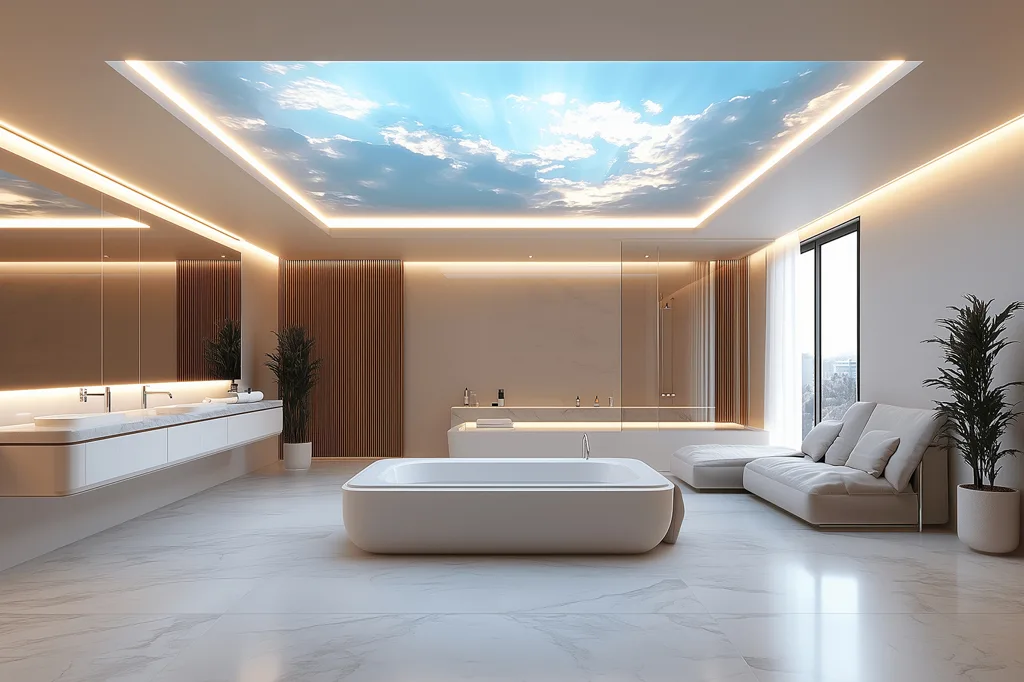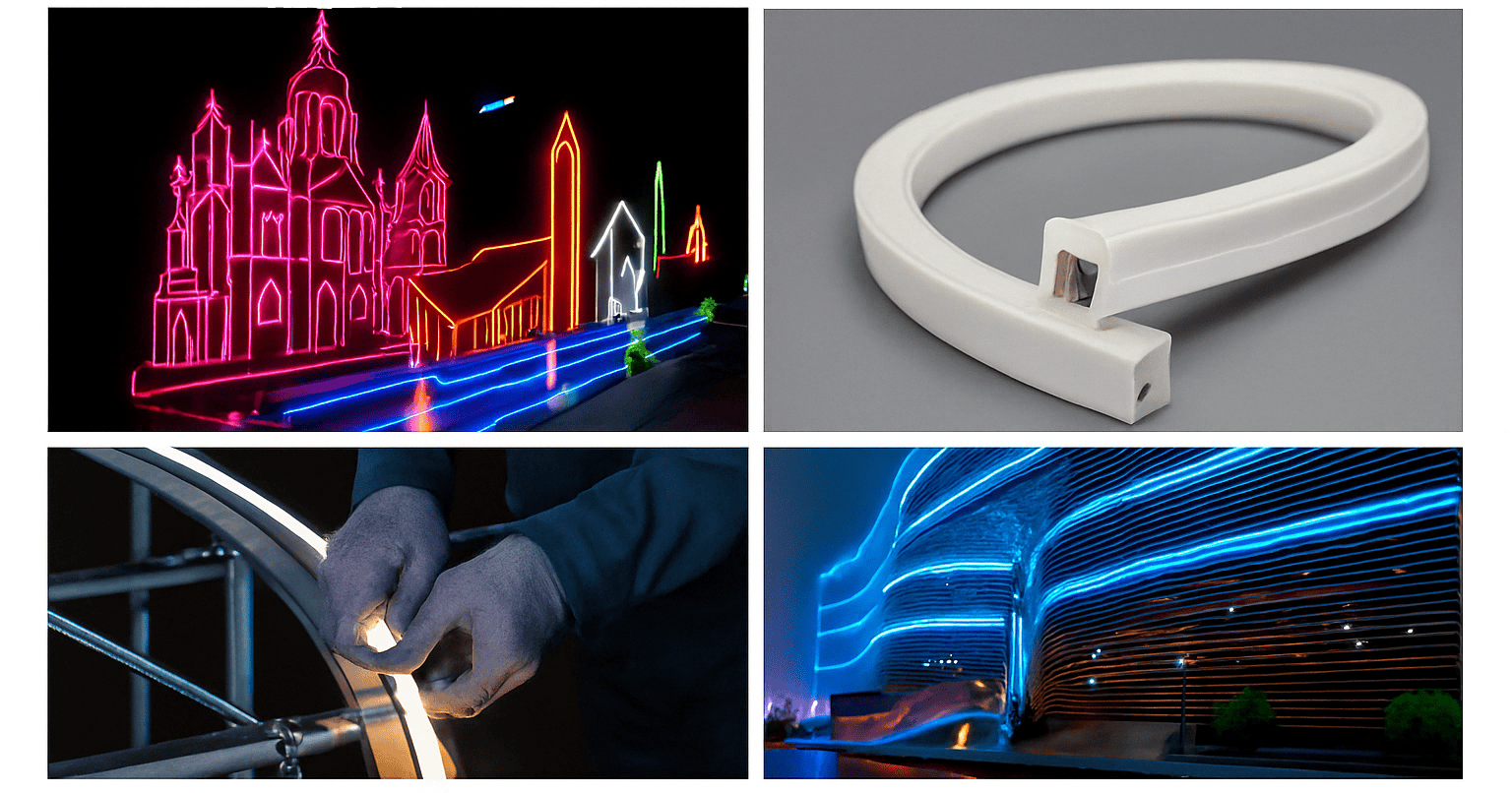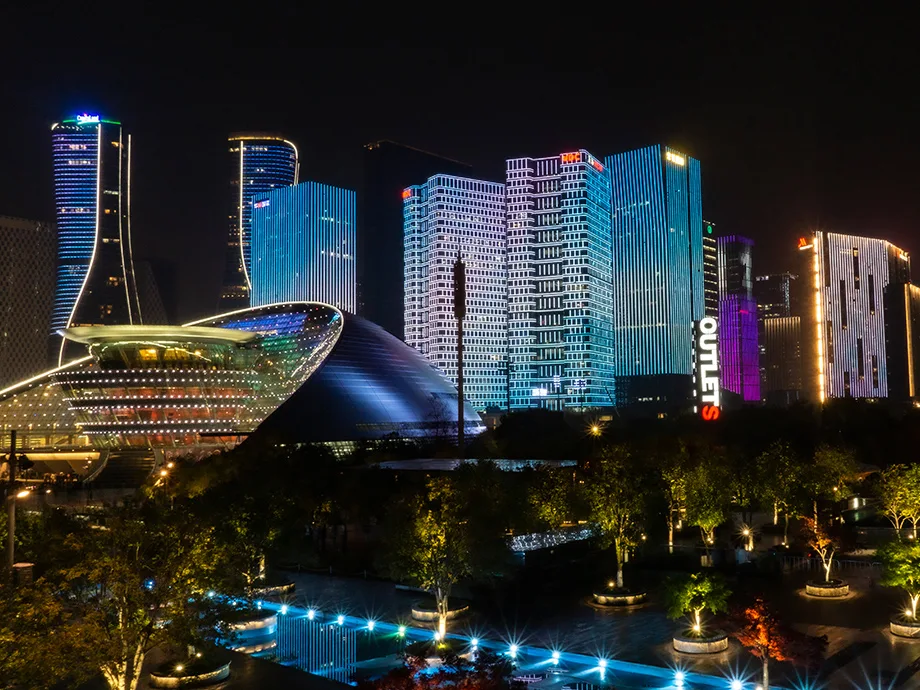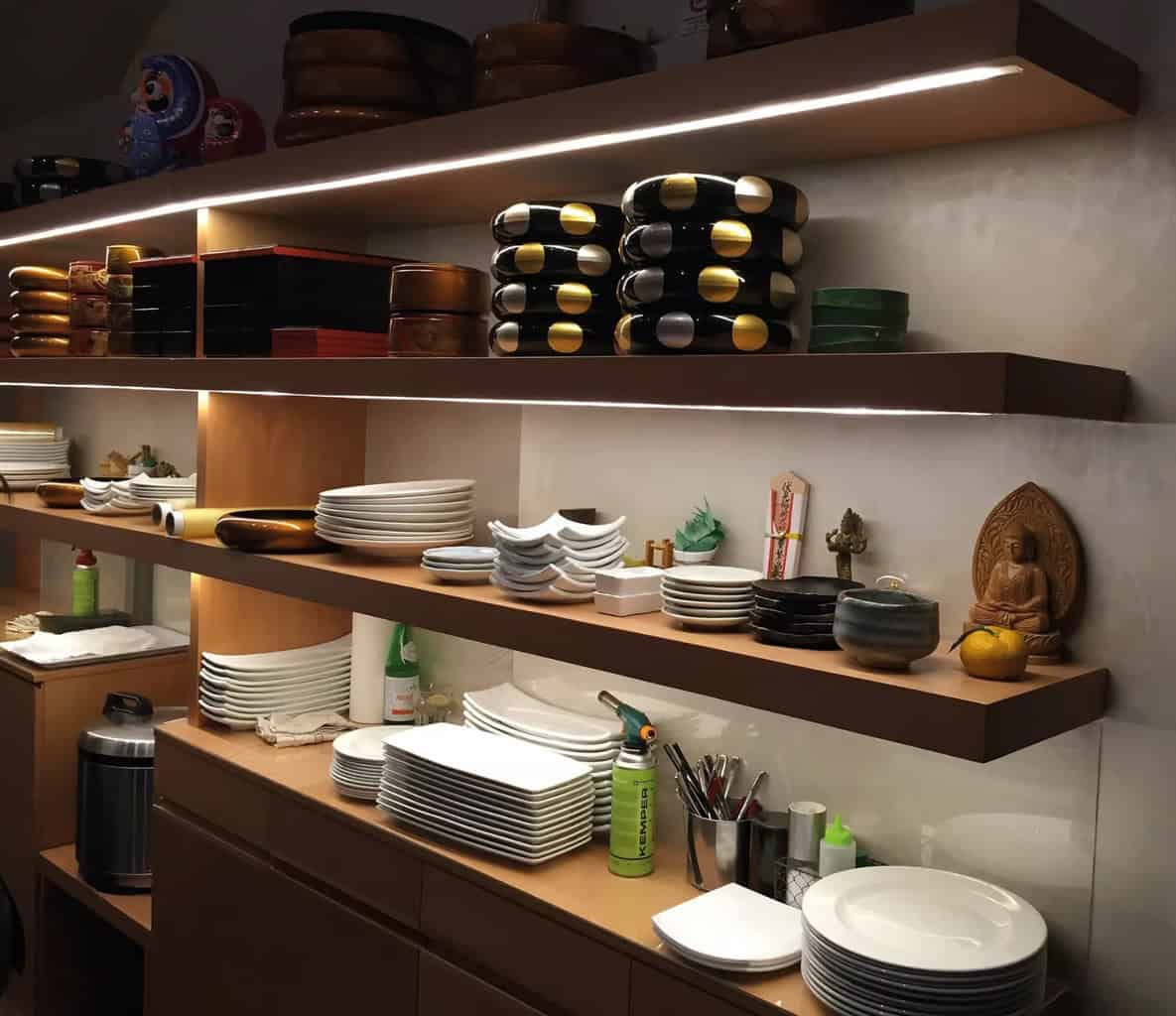A versatile interior decorative lighting solution that can revolutionize any space while offering a myriad of functional benefits, stretch ceiling lighting is an innovative approach to LED lighting that combines aesthetics with a variety of practical advantages.
Stretch ceiling lighting has become increasingly popular in recent years. They offer a variety of advantages over traditional lighting systems, including even illumination, a relaxing ambience, and minimal glare. In addition, they can be used for a variety of lighting purposes, such as ambient lighting, general lighting, and even workplace lighting.
Stretch ceilings are a suspended ceiling system consisting of two basic components: a track and a lightweight PVC or fabric membrane that stretches and clips into the aluminum track. Not only does this system offer a myriad of options for your interior design toolbox, but it also offers a range of practical advantages. However, designing and installing illuminated stretch ceilings can be a daunting task, and a variety of factors must be taken into account to ensure the best results. Read on in this article as we take you on an in-depth tour of this groundbreaking world of interiors.
What is a stretch ceiling?

A stretch ceiling is basically a second layer of ceiling that covers the initial ceiling. A stretch ceiling is in fact a suspended ceiling system, the key difference being that a stretch ceiling completely preserves the initial ceiling.
Stretch ceilings consist of two basic components: a perimeter track and a lightweight PVC fabric membrane that stretches and clips into the track.
The PVC-based stretch fabric material is 0.2 mm thick, 100% recyclable, and available in a wide range of colors and finishes, including matte, satin, translucent, high-gloss lacquer, and perforated. The material can be printed or painted for added effect, acts as a moisture barrier, and is completely waterproof and washable. The material is also maintenance-free, hygienic, non-toxic, and has a fire rating of B-s1,d0 (equivalent to Class 0).
The lightweight panels are custom-made from rolled material and can be formed into any shape and size, typically up to 50 square meters in one piece, with harpoon edges that can be clipped into the perimeter track. This adaptable design allows for the integration of a variety of lighting fixtures, from ambient light diffusers to sophisticated exhibition lighting, enhancing the function and ambience of the room.
Often the preferred choice of most architects and designers, semi-concealed PVC track can be easily formed into curves, domes, vaults, and many other shapes. Manufacturers also offer aluminum track options if needed to meet other specifications.
In addition to ceilings, the system can be used for walls, as light diffusers, floating panels, exhibitions, and creative shapes. Tensioned ceilings allow for the integration of all types of luminaires, grilles, and fixing points using separate background supports. Almost any type of aperture can be integrated in a stretched ceiling.
What are the advantages of stretch ceiling lighting?
Stretch ceilings are easy to install, low maintenance, reliable, cost-effective, and come in a wide variety of designs and finishes. One of the most remarkable features of stretch ceiling lighting is its unmatched versatility in design. Whether you want to create the high-gloss appeal of a hall or the matte finish of a cozy den, the possibilities are endless. Let’s take a look at some of the advantages that make stretched ceiling lighting a decorator’s dream:
Improve the Appearance of A Room
Stretched ceiling lighting can make any room look better. The fabric can come in different colors and designs. When you add light behind it, your room will have a soft, even glow. This type of lighting can make your space look larger and more welcoming.
Energy Efficiency
One of the main benefits of stretched ceiling lighting is energy savings. The lights used behind stretched fabrics are usually LEDs.LED lights use less electricity than regular light bulbs. This means you can save money on your electric bill while still having a bright, light home.
Easy to Install
Stretch ceiling lighting is easy to install. The fabric is lightweight and flexible. This means it can be installed quickly and without much hassle. You don’t need to worry about heavy fixtures or complicated wiring. A professional can install it in no time, making it a hassle-free option for your home.
Low Maintenance
Tension ceilings are reliable and sturdy, which is why most manufacturers offer a 10-year installation warranty to give you peace of mind. They are easy to clean and won’t be affected by corrosion or moisture. This makes them the perfect choice for indoor pool ceiling systems.
Customizable Options
You can customize your stretched ceiling lighting to fit your style. The fabric comes in a variety of colors and designs. You can choose solid colors for a simple look or patterns for a more exciting look. You can also choose the brightness of the lights. This means you can create the perfect atmosphere for any room in your home.
There are many advantages to using stretched ceiling lighting, but it also has some disadvantages. You can only install a stretched ceiling once and will have to replace the entire material, for example, if you need to carry out maintenance work on the wires/LED lights in the ceiling. Therefore, you should carefully consider when you will need to access the wires/LED lights in the ceiling next time. There are also limitations on the size of stretched ceilings. Depending on the manufacturer, they can be used to cover a maximum of 50 to 100 square meters.
Where are stretch ceilings suitable for use?
The innovation of using stretch ceilings not only creates stunning spaces but also gives them character and functionality that traditional ceilings can’t match. As interior design trends evolve, stretch ceilings are paving the way for a stylish and smart future.
Whether you’re renovating a home, designing a new office, or remodeling a commercial space, remember to look up—because the sky, or more specifically the ceiling, is the limit. Stretch ceilings can revolutionize the way we view the space above our heads. Let’s explore how they can be used in a variety of environments to enhance the ambiance and function of each.
Home Spaces
Stretch ceilings can be a vehicle for personal expression. They can reflect a homeowner’s taste and style, creating spaces that range from serene and ethereal to vibrant. Imagine a bedroom ceiling that brings the serenity of a soft dawn sky, or a living room that seems to open up to the heavens on a starry night lit by LEDs.

Children’s Spaces
In children’s rooms, stretched ceilings can be transformed into dynamic canvases with bright colors, favorite characters, or educational elements like maps and solar systems. Combined with low maintenance and durability, parents can rest assured that beauty and practicality go hand in hand.

Business Environments
For businesses, stretch ceilings can enhance brand image and provide a comfortable environment for employees and customers. In retail spaces, they can be used to direct attention, control acoustics, and enhance the overall shopping experience.

The hospitality industry (including hotels, restaurants, and spas) can utilize tension ceilings to create a unique and memorable experience for guests. Lavish patterns, recessed lighting, and even soundproofing elements can turn an ordinary visit into an extraordinary experience.
Tensioned ceilings in healthcare environments can have a positive impact on the rehabilitation environment. Adding soothing colors and designs to create a serene atmosphere can refresh patient recovery rooms, waiting areas, and treatment facilities.
Factors to consider before installing stretch ceilings
Designing and installing illuminated stretch ceilings can be a daunting task, and a variety of factors must be considered to ensure the best results. These include choice of materials, choice of LED lighting source, distance between the lighting source and the ceiling, shape and height of the ceiling, etc. Let’s explore each factor in more detail:
1. Choice of material
The semi-transparency of the stretch ceiling material plays a crucial role in determining light transmission and overall lighting quality. When choosing a semi-transparent tensile ceiling, it is important to consider its light transmission. For simple white ceilings, we recommend a minimum of 50% light transmission. It is important to install the material with the highest transmittance as it reduces the LED installation and operating costs of the illuminated ceiling.

When choosing a lighting source, please also consider the light transmission. For example, if you need 5,000 lumens for a 20-square-meter living room, an LED behind a translucent material with a transmittance of 50 percent should have a luminous flux of 10,000 lm. And if you’re using a printed pattern on the ceiling, avoid highly light-absorbent colors, such as black or dark gray. Warm colors are best suited for this application.
2. Selection of LED lighting source
The choice of LED lighting source is also crucial as it will affect the brightness and energy efficiency of the stretched ceiling. Choose energy-efficient diffuse backlit LED strips or flexible backlit LED strips with a minimum of 100 lm/w to ensure that the stretched ceiling has the highest luminous flux with the lowest energy consumption.
It is also important to select an LED light source with the correct light output and number of LEDs. The purpose of lighting the space should determine the type of light source to be used. For white stretched ceilings with 50% light transmission, the following values for luminous flux per square meter of LED modules can be used as a useful positioning aid:
- Ambient light: 500 – 1000 lumens/square meter
- Residential general lighting: 1000 – 2000 lumens/m²
- General lighting for commercial and business use or workplace lighting: 2000 – 8000 lumens/m²

Diffuse Backlit LED Rigid Strip Light
- Model No.: RQW1210AN
- Voltage: DC12V
- Power: 12W
- Lumen: 1500lm
- Ra: >80
- CCT: 2700 – 6500K
- LED QTY: 12LEDs
- Beam Angle: 170°
- IP Rating: IP20/IP65
- Dimensions: L950mm x W15mm
- QTY/Chain: 20pcs
Price: USD $0.64-0.86/pcs
3. Distance between the LED lighting source and the ceiling
In order to obtain an even illumination without any hot spots or dark areas, LED strips or backlit LED rigid strips must be evenly distributed behind the translucent material.
For best results, we recommend a distance of at least 30 cm and at most 50 cm between the light source and the translucent material. The distance between each LED strip or module should be equal to the distance between the LEDs and the stretched ceiling. LED strips with diffuse lenses have an angle of 180 degrees, for which the distance ratio should be 1.5. This results in the need to use more LEDs to obtain uniformity, which can have a significant impact on installation and operating costs.
For example, for a depth of 30 cm, the distance between light sources (rows of LED strips or individual backlight LED modules) should be:
- 120-degree viewing angle: 30 cm
- 180-degree viewing angle: 45 cm

Diffuse Reflective Flex Backlight LED Strip Light With Lens
- Model No.: FQX15B12C/FQT15B24C
- Voltage: DC12V
- Power: 10W/20W
- Lumen: 1500lm/3000lm
- Ra: >80
- CCT: 2700 – 6500K/Dual color
- LED QTY: 12LEDs/24LEDs
- Beam Angle: 170°
- IP Rating: IP20/IP65
- Dimensions: L5000mm x W15mm
Price: USD $1.81-2.29/meter
4. Quality of the LED light source
The quality of LED lighting is usually related to the color rendering index; LED lights with a high color rendering index can more accurately restore the color of the object itself. For general lighting purposes, we recommend using light sources with a high-quality spectrum and a color rendering index (CRI) of at least 80. Choose LED strips with a CRI of at least 90 for all work and living areas (e.g., offices, living rooms, dining rooms, bedrooms, etc.).
To learn more about CRI, read the post Is 95 CRl Good for LED Strip.
LED light sources with a long lifetime and minimal color change over time are also recommended, especially for large installations. If the brightness of the light source fades too quickly or the color temperature changes, replacing the entire installation may otherwise be the only solution to achieve even lighting. Therefore, choose the LED module or strip that has the longest life, least color change, and best lumen maintenance.
5. Ceiling Shape and Height
Luminous stretched ceilings can have individual shapes and even translucent images. From a lighting design point of view, uniform light should be complemented by spotlights or luminaires to draw attention to certain areas or objects. Therefore, consider the shape of the luminous stretch ceiling and the lighting design requirements of the space.
And the height of the ceiling affects the type and number of LEDs needed to illuminate the stretched ceiling. The higher the ceiling, the more power the LED module or strip must have to achieve the same level of illumination. Therefore, ceiling height should be considered when selecting an LED light source.
6. Hire a professional for installation
Properly designing and installing lighting to stretch ceilings presents a unique set of challenges. Therefore, it is recommended to hire a professional to perform the installation to ensure the best results. A professional will consider all of the above factors and ensure that the illuminated stretch ceiling is properly installed and meets the lighting design requirements of the space.
How do I install a stretch ceiling?

To help you better understand stretch ceilings, we will walk you through the entire installation process. Please do not attempt to install a stretch ceiling yourself; leave it to the professionals.
Step 1: Measure the room
Make a sketch and measure the room in advance. Remember to add at least 20 centimeters of PVC film to the tension ceiling so that it can be easily fixed later. Measure the dimensions of the room in order to install the necessary fastening profiles and ensure that there is a cutting allowance.
Step 2: Customized design
After measuring the room, the tensile ceiling needs to be designed. Tension ceilings can be customized as painted ceilings, mirrors, translucent, backlit ceilings, or panels. You need to choose the color, finish, and fabric, and then the manufacturer will design the ceiling according to your needs.
Step 3: Preparation for Installation
If your room is usually painted with plastered ceilings, then your room does not need to be completely cleaned out. You may just need to free up a little space, and you can begin installation almost immediately.
Step 4: Installing the Rails
Next, PVC or aluminum track will be installed on all four walls of the ceiling, securing it to each wall. The track will become the ceiling structure and maintain the shape of the ceiling. If the stretched ceiling is going to cover a larger space, an aluminum track will need to be installed on the ceiling to connect the fabric panels.
Step 5: Installation of LED Lighting System
Install diffused LED strips or LED backlit rigid strips, LED drivers, and other systems (such as smoke alarms) into the original ceiling. You will need to test the LED fixtures after installation in order to check for incorrect wiring of the LED lights and LED drivers.
Step 6: Heat and Install the Flexible Ceiling Film
In order to stretch the ceiling upholstery into place, you will need to increase its elasticity using the heat generated by a portable gas heater. Once the room temperature reaches approximately 40 degrees Celsius, the flexible membrane-stretched ceiling will be optimally flexible and can be stretched and installed in place. When the temperature returns to normal, the flexible membrane will strengthen and tighten back to its original shape.
Step 7: Final Cleaning
Finally, any handprints or marks on the ceiling upholstery are wiped away with a damp cloth, and your stretched ceiling is installed.
Compare: stretch ceilings or drywall ceilings?
The leveling and cleaning of ceilings is a complex operation that requires a large investment. However, stretch or drywall construction does not require additional surface preparation. In order to determine whether you want to use drywall or stretch ceilings in a room, you need to compare them on the main parameters.
Installation comparison
To install stretch ceilings you must hire professionals. They will not only stretch the flexible membrane but also create it. Installation of such a stretched ceiling requires special equipment and experience in installing such structures. However, this work does not require vacating the site and does not generate a lot of construction waste.
Installing plasterboard ceilings generates a lot of construction dust and garbage. You have to move everything out of the room. Then you need to spend a lot of energy cleaning the room. However, if you build drywall ceilings by hand, you can save money. And this is possible if you will use construction tools and do the repair work yourself.
Also, there is a difference in the speed of installation between tension ceilings and drywall ceilings:
- Standard ceiling tension type takes about 3-4 hours to install.
- Gypsum board ceilings take 2 to 4 days to produce. Everything depends on the size, complexity of the room and the ceiling itself. If the design is quite complex, then it will take more time.
Comparison of Room Height Loss
Tensioned ceilings slightly reduce the height of the room when fixing the rails to the wall, usually between 30 cm and 50 cm. Plasterboard ceilings are constructed to reduce the height even further. So this should be taken into account in rooms with low ceiling heights.
Built-in Light Fixtures VS.
It is very easy to hide wires and light fixtures under stretched ceilings. And, if a fixture needs to be replaced or the lighting system changed, this is easy to do. The wires and fixtures are also well placed in the framework of the plasterboard structure. Therefore, plasterboard ceilings and stretched ceilings are equivalent in this respect.
Maintenance Comparison
PVC linoleum, or soft film, requires very little in terms of maintenance. Wiping with a damp cloth is sufficient. Whereas gypsum board ceilings require maintenance and may sometimes need to be painted.
Durability Comparison
Soft film stretched ceilings can be easily punctured. Of course, anything can have a puncture. While you can seal these ragged holes, it’s not very aesthetically pleasing, and the security of waterproofing disappears. Comparatively speaking, drywall ceilings are more durable.
Fire Rating Comparison
Neither flexible film ceilings nor drywall ceilings support combustion.
Service Life Comparison
Gypsum board ceilings have a warranty of up to 10 years. To get a new look, the structure must be painted. For PVC stretched ceilings, the warranty is 10 to 15 years. In the meantime, there is no need for any cosmetic repairs.
Comparison of Temperature Resistance
PVC tensile sheets are afraid of cold. You cannot use tensile ceilings in unheated areas. Drywall ceilings can withstand temperature changes.
Comparison of Decorative Qualities
Stretch ceilings can be almost any color. It can be a bright or soft monochrome, an interesting drawing, or a reproduction of some famous painting. Plasterboard ceilings can be designed in different ways, using different textures, paints, or tiles. Multi-layered ceilings look very unique with a wide and unlimited range of colors.
Cost Comparison
Plasterboard ceilings are three times cheaper than stretched ceilings. In addition, the price depends on the size of the room, the number of corners, curved sections, and originality.
Conclusion
With the rise of smart home technology, stretched ceilings can be designed to integrate with IoT devices to create seamless, futuristic environments. Think voice-controlled lighting, embedded speakers, and even security features. Eco-conscious individuals will appreciate that tensile ceilings are not only recyclable but also contribute to the sustainability of a space by reducing energy consumption through their insulating properties.
At the same time, stretch ceiling lighting is a great way to improve the lighting in your home. It’s stylish, energy efficient, and easy to install. Whether you’re looking to update your living room, kitchen, bedroom, or bathroom, stretch ceiling lighting can help. Consider your room size, usage, and budget to choose the right lighting for your space. Hire a professional for installation and follow maintenance tips to keep your lighting in great shape.
SignliteLED is a factory specializing in producing high-quality custom backlit LED strips and backlit LED lens rigid bars. If you need to purchase stretched ceiling LED light sources, please contact us.




